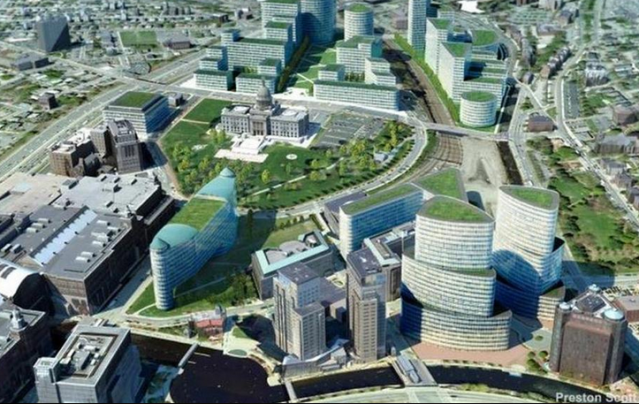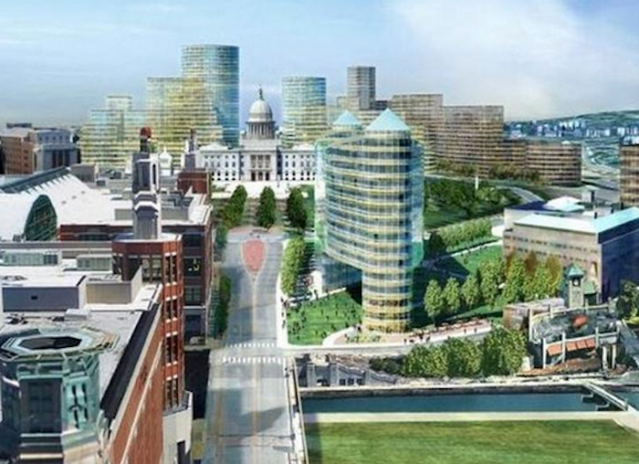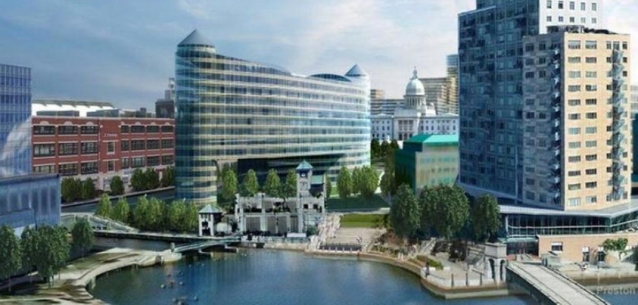
From Rhode Island proposal for HQ2. (all images CommerceRI)
Two major eastern cities have won the HQ2 sweepstakes, and you have to wonder whether the twofers – Long Island City and Crystal City, outside Manhattan and D.C. – both realize they got half a loaf.
How soon will it take for them to recognize that getting half a loaf was to have dodged the full loaf of total victory in this Amazon sweepstakes? The cities that made it to the last round of 20 may be wiping their brows in retroactive relief. Cities like Providence, which managed to avoid Amazon’s attention altogether, may still be counting their lucky stars.
New York City and Washington, D.C., are probably large enough to embrace HQ2 and its 50,000 ÷ 2 jobs without major injury. Even longer commutes and even tighter budgets are not death warrants for such big places. Providence would have been inundated, losers both financially and in quality of life. Probably no midsized city would have been hurt as badly as Providence.
One of Providence’s two major competitive advantages – its historical character (can’t do much to stop its location between Boston and New York) – would have gone the way of the dodo. Many citizens and civic leaders are already doubtful that the city can absorb the proposed 46-story Fane tower. But there’s no question that Amazon would have clobbered the city’s beauty without blinking an eye. Still, how many Rhode Islanders were rooting against HQ2? Not many, I’d imagine.
Reader Michael Airhart commented today on one of my posts on Rhode Island’s HQ2 proposal from a year ago, “R.I’s Amazon HQ2 bid.” After describing Crystal City’s probable fate – “a cluster of a dozen cookie-cutter glass buildings crammed up against the main terminal of National Airport” (here they would have been crammed up against the Rhode Island State House) – Airhart wrote:
Did Providence ever stand a chance of attracting Amazon? No. And I think that reality only strengthens David’s contention that Providence and the state should have played to the city’s strengths — its historic architecture and culture — instead of trying to copy everyone else. Amazon would still have said no, but Providence could then have caught the attention of other companies. Pretend-ing to be like everyone else doesn’t impress the businesses that are likely to consider Providence.
So true. We dodged a bullet. A very big bullet. If we had played hard to get by demanding that Amazon build out its HQ so as to fit into Providence’s historical character, Amazon might have noticed. Probably not, but other big businesses might have, as Airhart suggests. Leave it to the “creative capital” to regurgitate the worst ideas from everywhere else!
Not everyone was against letting such a fate befall Providence, a year ago or today. Many people favor the proposed Fane tower. Many others oppose it, some because of its effect on the historical character of Providence. Yet how many of these latter oppose all of the other carbuncles planned or under construction in the I-195 corridor? Not many, I’d guess. How many opposed the GTECH building? How many opposed the Rubik’s Cube and the many other attacks on the city’s historical character that have arisen since the 1970s. Not many, I wager! And yet those buildings were no less an attack on Providence’s historical character than the Fane tower is today.
Fortunately, because the city avoided two major urban renewal plans of the 1960s that would have destroyed downtown and College Hill, Providence has so much more beauty here than most cities that developers and foolish civic leaders will need all 1,000 cuts to achieve the death of its beauty. But those slow-death-of-a-thousand-cuts are coming faster and faster.
Wake up, Providence!





Yes, that is true. My observation is that the original Hope Point Tower renderings were grossly out of scale, lacking clarity of design, and lacking context.
I believe that the tower will be much better than even the last rendering – the one at the council meeting and in ProJo. And remember, it is a mere 5 blocks from the other towers. Hardly “looming”.
LikeLike
Yes, to a large extend you are correct – but – there have been cases of the city moving developers off to a more acceptable design. Especially in PVD where several options can fit nicely into the fabric…brick, stone, combos, etc.
LikeLike
My sense is that Northern Virginians are relieved that we are receiving only half of Amazon’s new headquarters, and that Virginia spent comparatively little on incentives. We got a great return on investment. A full headquarters would have driven local living costs and employers’ payroll costs sky-high.
Amazon appears to have respected Virginia for not prostituting itself, and for focusing on infrastructure instead of corporate giveaways. Perhaps Providence should rethink its desperate desire to appeal to rogue developers.
LikeLike
You make a good point relative to the IGT and Wexford buildings. That’s where design review failed. I don’t know why, because that’s where the “rubber meets the road” in terms of fitting into the PVD character. My point is that is where we should hold developers to the fire.
LikeLike
When design review panelists have as one major aim to protect the city’s historical character, Steve, then it can be effective. If not, it will not be. And that has not been a goal of design review in Providence … ever. EVEN THOUGH IT IS THE LAW!!!
LikeLike
Amazon’s buildings were an attack on Providence’s historical character – nor is
the Fane tower. Renderings are of minimal concern. Design review always fixes that.
LikeLike
I don’t know whether you mean, Steve, You have made an editing error that obscures your meaning. But either way, from the Wexford building on the I-195 corridor going all the way back to GTECH and beyond, these buildings have been through design review and it did not help. Design review must be concerned with contextuality for it to do the right thing, but it is not here in Providence. It doesn’t look like there is any pressure to radically change the design of the Fane tower to something that would fit in.
LikeLiked by 1 person
It’s my impression that conceptual renderings do approximate reality. They don’t reflect the exact structure, shape, and exterior of future buildings, but they do convey the expected architectural style and approximate size to reflect a project’s context within its environment.
Nobody renders a glass tower when they think that a brick landmark might be built.
LikeLike
The renderings are supposed to show the building in it’s best light. That’s why none of the Hope Point Tower renderings show it as most of us will experience it, either looming above us as we drive by on Eddy, or even worse, as our sole view as we cross the pedestrian bridge.
Sometimes the renderers can screw up, though. The Edge College Hill (the new 15 story tower on Canal) is not as ugly as the rendering made it seem.
LikeLike